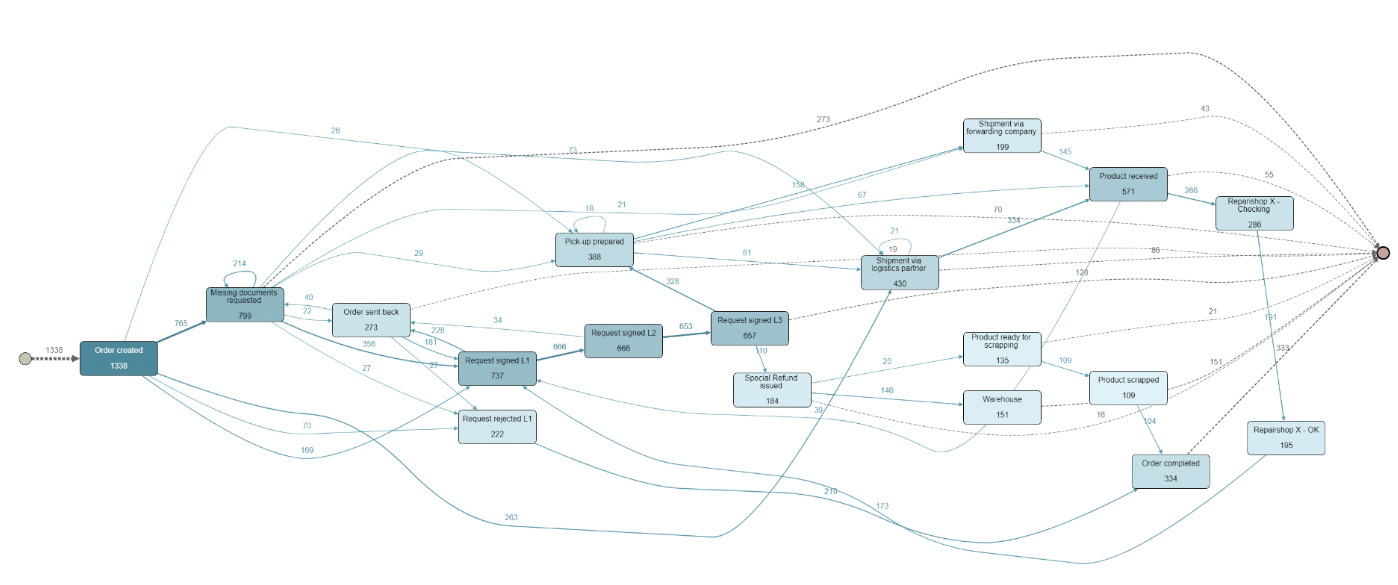On June 28, I had the opportunity to attend a conference sponsored by Celonis, a leader in G2's Process Mining category.
This was a great opportunity to attend training sessions, learn more about process mining, and hear from users of process mining software.
The conference was dubbed Celonis World Tour 2023, as they made 10 stops around the world, starting in Munich and wrapping up in Chicago.
What is process mining?
Process mining, also referred to as process automation or process intelligence, is a technique used in the field of data analytics and business process management to analyze and visualize the actual processes that occur within an organization.
Process mining aims to gain insights into how processes are executed, identify inefficiencies, and improve overall process performance.
Optimizing complex operations to enhance business performance
The process mining approach involves extracting and analyzing data from various sources, such as event logs, transactional data, or audit trails, that capture the activities and interactions between different components in a process.
The data is then used to create process models representing the actual flow of activities and events.
Once a process is visually mapped out, the platform finds inefficiencies, suggests alternatives, and can push new processes back into relevant systems. It can also outline costs and time saved based on different workflows and process improvements.

Source: Arvato
Process mining is especially beneficial for complex processes with a large volume of data, where it can be challenging to identify issues and inefficiencies manually.
By leveraging the power of data analysis and visualization, process mining software provides organizations with valuable insights to optimize their operations, reduce costs, improve customer satisfaction, and enhance overall business performance.
Key takeaways from the conference
Some categories I manage on G2 that leverage process mining include AP Automation, Accounts Receivable, Order Management, and Procurement.
Therefore, I wanted to better understand this process and how it affects my categories and the products within them.
I first attended the opening keynote by one of the Celonis co-founders, Alexander Rinke, who discussed what process mining is, how it works, and its various use cases. I heard from enterprise companies (FedEx, Nationwide, Merck) that use process mining in their procure-to-pay processes, invoicing, collections, and various accounting functions.
I also attended a session about taking advantage of process intelligence within finance departments to improve cash flow, reduce costs, and accelerate productivity. This helped me understand how process mining can be used in various platforms to improve workflows and processes.
I learned that the products in Procurement, and Accounting & Finance categories can use process automation in the following ways:
- AP automation: It can help centralize data across systems and streamline process execution to minimize late payments, take advantage of cash discounts, and increase the touchless invoice rate (invoices that are received, reviewed, approved, and paid automatically).
- Accounts receivable: It can help improve cash flow, prioritize collections, and reduce the amount of past due invoices by monitoring risk, outstanding balances, and payment term compliance.
- Order management: It can help gain visibility across orders, prioritize the handling of orders, and increase the end-customer experience by automating order entry, measuring KPIs, and identifying bottlenecks and inefficiencies.
- Procurement: It can be useful for maximizing purchasing power, minimizing risk, and cutting costs. This is achieved by ensuring vendor contracts are in compliance, maintaining accurate lead times for on-time delivery, consolidating purchases, and negotiating better terms with suppliers.

The state of process mining on G2
G2’s Process Mining category currently has 92 products, 18 of which are on the G2 Grid®. Over the last year, the category grew by 30%, adding 21 new products, while its review count increased by 41%, with 375 reviews.
This increased popularity and interest in process mining is no surprise, especially in the current challenging technology sector where companies are trying to optimize their operations and improve overall performance.
G2's review data reveals the top factors that positively impact user satisfaction scores in the Process Mining category, as shown below.
The top three factors include:
- Execution management: This allows users to analyze processes, find bottlenecks, and identify the gaps between how things should be and how they are.
- Ease of use: This describes how easily users can use a software product.
- Process library: This provides users with a repository for process maps and documentation.
Choosing the right process mining software
Our review data further highlights that to be effective, process mining products must be easy to use, provide data-driven insights into current processes, and allow users to easily find and view process maps.
At G2.com, you can compare these features, along with many more in the Process Mining category, to find the best software that fits the particular needs of your organization.
Learn more about improving daily business operations with process optimization.
Edited by Jigmee Bhutia


 by Nathan Calabrese
by Nathan Calabrese
 by Nathan Calabrese
by Nathan Calabrese
 by Nathan Calabrese
by Nathan Calabrese